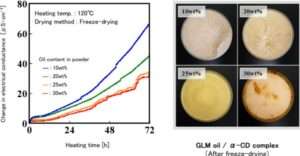MCT powder is a product that you should not be using. In order to make the MCT oil into a powder, the oil must be heated to a high temperature and mixes with the drying agent. Most of the time maltodextrin is used. When MCT oil is heated the oil will oxidize and make it very unhealthy to consume. Oxidation is very bad. Instead, always buy liquid MCT oil, do not but MCT powder.
As of August 31st 2021, my current recommendation for MCT powder is this.
Favorable Effects on Atherosclerosis, Energy, and Aging:
Medium Chain Triglycerides and MCT powder (MCTs) are a unique form of dietary fat that impart a broad range of positive health benefits. Nevertheless, the possible anti-aging properties of MCTs have been largely unrecognized. Dietary fats are molecules composed of individual carbon atoms linked into chains including 2 to 22 carbon atoms in length. Long-Chain Fatty acids (LCTs) ranging from 12 to 18 carbons long are the predominant (prevalent type) form of fat in the American diet. MCTs, by contrast, are composed of only 6 to 10 carbon links. As a result of their shorter chain length, MCTs have several unique properties which give them advantages over the more common LCTs.
Until the early 1980s, MCTs were primarily accessible exclusively as a constituent of coconut oil, butter, and other natural sources. However, Dr. VigenK. Babayan of the Nutrition Laboratory, Harvard University, developed a procedure to create them in large quantities, to be used primarily for therapeutic uses in a number of conditions.
MCT give around 10% fewer calories than LCTs – 8.3 calories per g for MCTs versus 9 calories per gram for LCTs. But this can be merely among the unique advantages of MCTs. More importantly, reduced chain length also means that MCTs are more rapidly/quickly absorbed and consumed by the body and more immediately metabolized (burned) as fuel. The result of the accelerated metabolic conversion is that instead of being stored as fat, the calories contained in MCTs are efficiently changed over into fuel for prompt use by organs and muscles.
The energy-enhancing properties of MCTs are credited to the fact they do not demand the existence of carnitine, as do LCTs and cross the mitochondrial membrane that is double very quickly. The result is an excess of acetyl-CoA, which afterward follows various metabolic pathways, both in the mitochondria (Krebs Cycle) and in the cytosol, causing the production of ketones. Scientists attribute the energy that is increased from the consumption of MCTs to the accelerated formation of ketone bodies. MCTs are consequently a good option for anyone who has increased energy needs, as following major surgery, during ordinary or stunted development, to enhance athletic performance, and to counteract the decreased energy generation that results from aging.
Recently MCTs and MCT powder have gained in popularity with athletes seeking to increase energy levels and improve endurance during high-intensity exercise, in addition to functioning as an alternative energy source for athletes on high-protein, low-carbohydrate diets. Researchers have previously demonstrated that physical endurance cans increase in animal studies. In swimming capacity evaluations, mice fed a diet containing MCTs outperformed mice fed a diet including LCTs. The researchers noted that the muscles of mice fed the MCTs produced higher amounts of essential metabolic enzymes (3-oxo acid CoA transferase, citrate synthase and malate dehydrogenase) involved in the Krebs cycle (tricarboxylic acid cycle), the body’s primary energy production mechanism. MCT-fed mice also burned fat at an increased rate to improve cellular energy generation.
MCT powder and Weight Control:
As well as their lower caloric content than LCTs, MCTs aren’t stored in fat deposits in the body as much as LCTs. Additionally, MCTs have been proven to improve thermogenesis (i.e., fat burning). So MCTs seem to offer a triple approach to weight loss they contribute to increased metabolism to burn more calories, are minimally kept as fat, and have a lower calorie content than other fats. This third property maybe because of the fact that MCTs act metabolically in some way just like their boosting the development of ketones, in addition to carbs, as mentioned above. Ketone generation is a basis of the Atkins Diet, and MCTs may enable those following the Atkins’ system to more quickly obtain advantages and more readily adhere to the program. Ketones are also among the two materials which the brain can use for energy.
Kaunitz and coworkers performed a study on rats, to compare the effects of diets where the fat was supplied lard or by MCTs. The MCT-fed rats lost significant weight, although their calorie eating was the same as the lard-fed rats. Additionally, Kaunitz described the MCT-fed rats as having “a survival rate that is exceptional.” In another study, researchers found decreased weight gains, reduced fat content, and unchanged whole-body protein content in MCT-fed creatures in comparison to control animals. In a third study, fat deposits in rats fed diets high in MCTs were twenty-three percent less than in LCT-fed rats.
Animal results have been supported by human trials. In one study researchers fed six slim and six obese young men meals containing either long-chain triglycerides (LCTs) or MCTs plus LCTs. In both lean and obese individuals, post-meal thermogenesis (fat burning) was accentuated after consuming meals featuring MCTs. 7In another study involving a group of obese girls on limited diet researchers noted that insulin profiles enhanced when MCTs constituted 24 percent of the total consumed calories.
Calorie-restricted diets in many cases are connected with noticeable declines in energy. Several studies support the edges of using MCTs in weight loss programs to increase fatty acid metabolism to help in reducing fat deposits and to foster energy levels. In one study when research workers in Czechoslovakia treated sixty overweight patients they reasoned that MCTs offered several edges, stating, “Administration of… medium-chain fatty acids can… improve the long term success of diet treatment of patients that are fat.”
Hunger Control:
MCT powder & MCT powder have been proven to curb desire, an ability of clear advantage for those trying to lower their consumption of total calories. In one 14-day study, six healthy male volunteers were permitted unlimited access to one of three diets: an MCT diet that was low, a moderate MCT diet, and an MCT powder diet that was high. Caloric consumption was significantly lower on the MCT diet that is high. The researchers noted that replacing MCTs for other fats in a high-fat diet “can restrict weight gain and the excessive energy intakes generated by high fat, energy-heavy diets.”
MCTs and Atherosclerosis:
MCTs have several properties which could be advantageous in preventing atherosclerosis. Among these are that MCTs have anticoagulation effects, and have been shown to lower serum cholesterol in rats 11 and calves. Moreover, MCTs reduce amounts of cholesterol in the liver and other tissues. MCTs have also been reported to act as antioxidants and reduce tissue requirements for Vitamin E.
MCT powder has a little hypoglycemic (blood glucose-lowering) effect, and so maybe useful for diabetics, or anyone with a tendency for pre-diabetes (which includes just about everyone over 35). It may be the combination of the glucose and lipid-lowering report that “the life span [of experimental animals] is more when the diet is not poorer in MCTs than LCTs.”
Finally, another testimony to the benefit of MCTs in preventing cardiovascular disease and atherosclerosis is the state of Sri Lanka. The causes of death in many states were reported. Sri Lanka reported a death rate due to ischemic heart disease of 1 per 1,000,000. The figures for most countries changed from 38.4 to 187.7. It truly is essential that the prevalent dietary fat in Sri Lanka is coconut oil, which includes over 50 percent MCTs.
MCTs and Immune Augmentation:
To assess the immune-normalizing properties of Kaunitz, MCTs and co-workers injected rats with rabbit immune serum, known to cause serious autoimmune kidney disease in the rats. They noticed the pathological changes in the kidneys were substantially reduced in the MCT, and then managed MCT in the diet-treated group. Kaunitz supposed that MCTs could therefore have an optimistic effect “on autoimmune responses feature of the aging process.”
MCTs and Medicine:
MCTs have shown useful in treating several medical disorders that involve impaired or damaged lipid (fat) metabolism. Included in these are biliary cirrhosis, obstructive jaundice, pancreatitis, cystic fibrosis, celiac disease, Whipple’s disease, Crohn’s disease, regional enteritis, and malabsorption in neonates. MCT has been reported to be useful for feeding newborn infants, to both assist their first growing and to contribute to their physiological development. The absorption of magnesium and calcium seems to be accentuated when the diet contains MCTs, particularly in infants, and the absorption of amino acids also appears to be improved. Consequently, MCTs could be a useful addition to the diet of those suffering from any type of tissue or malnutrition wasting. In this respect, MCTs are frequently added to parenteral formulas for intravenous feeding following an operation or during recovery from burns, serious injuries, and diseases.
Conclusion:
The important adverse effect that is noted by starting users of MCT powder is nausea and gastric distress. Before long, MCT can be required by the tablespoonful. MCT oil can be used as a salad dressing, so when a cooking oil. Nevertheless, MCT should not be heated to temperatures above 150-160 degrees C, because it is going to oxidize and dislocate, adversely affecting the flavor. With those few caveats, MCTs are an especially advantageous supplement for fueling physical exertion, given their high energy density accelerated rate of absorption, content and quick metabolic conversion. Also, MCTs can be rapidly mobilized in the post-exercise recovery period to rebuild muscles and stop the failure of proteins (catabolism) that can occur when the body is putting a maximum demand on the body’s energy reservations.


